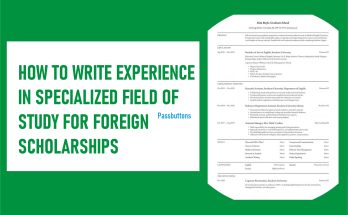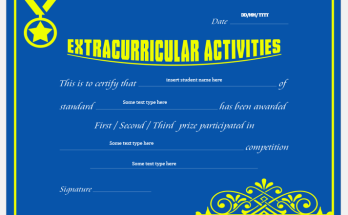2 Samples of a Good Statement of Purpose for International Scholarships: Most graduates who seek to further their studies at the master’s and PhD levels are often faced with the challenge of writing a compelling statement of purpose (SOP). Some of them settle for experts to write it for them in exchange for a huge sum. While others struggle to get it done in their own way. Whichever way, a statement of purpose is a prerequisite for studying in any graduate school, both locally and internationally. One interesting thing about SOP is that anyone can write a compelling and acceptable one. So, this article will teach you how to come up with your own in a unique way.
Over the years, we have discovered that most students find it very difficult to write this SOP, especially those who cannot afford the services of an expert. For this reason, Passbuttons has articulated this post to help students write a great SOP. This article will guide you on how to write it as well as give you 2 great samples to guide you. In addition, we offer admission, scholarships, jobs, and international scholarship services. We do this because:
At Passbuttons, we inspire, motivate, and support learners to have a fun & amazing learning experience and to become leaders that make an impact. We are just crazy about it. Join Passbuttons now for free.
Previously, we discussed the top 10 personal skills used for international scholarship applications. However, this article will centre on the 2 samples of a good statement of purpose for international scholarship, when, where and how to use them.
Statement of Purpose Overview
A statement of Purpose fondly called SOP is an academic statement which is a major requirement for a graduate school admission application. Moreover, the essence of writing an SOP is to primarily convince the graduate school admission committee to offer you provisional admission into a specific programme. It further demonstrates that you have carried out a primary study in that programme or course you are applying for and that you would wish to learn more about it. More importantly, the SOP also captures the fact that the department is the best fit for your programme choice.
It is worthy of note that, a statement of purpose is different from a personal essay or statement. In as much as it is not a personal essay, it should also contain details about your personal life to boost your chances of securing admission. Moreover, it is neither a creative writing piece but must be well articulated with correct sentences and unique vocabulary. However, this post will discuss in detail the structures of an SOP as well as how to write a good one. Let’s dive right in.
Others are currently reading
- 7 Irresistible Proof of Achievement or Research for International Scholarship
- 9 Community Services and Commitments Used for Foreign Scholarship Application
- 5 Samples of Letters of Recommendation for International Scholarship that Work
- How to Present Proof of Participation in Extra-curricular Activities for Foreign Scholarships
- How to Write Experience in Specialized Field of Study for Foreign Scholarships
- How to Get a Scholarship to Study in Canada | Latest Update
Structures of an SOP
Every great statement of purpose is made up of three main parts which include:
- The Introduction
- The body, and
- Conclusion
Now, let’s discuss them in detail.
Introduction
This is the first part of an SOP. It captures an introduction of yourself and answers the question of why you’re applying for the specific programme. It should further capture why you are applying for a master’s or PhD scholarship. This information enables the admission committee to have a better understanding of who you are and assess your suitability for the programme.
The body
Your statement of Purpose should discuss your academic background and professional experience. Some of these may include any part-time jobs, internships, training projects or full-time jobs that are in line with the subject matter. Moreover, it is at this point you showcase your skills and expertise. Tell the scholarship reviewers how good you are and make them see the reasons why you are the best for the scholarship. While stating the skills you’re good at, you should also include that you wish to improve on the skill. This now forms your basis for the application.
Furthermore, you must state clearly your reasons for pursuing the particular programme. Also, what you intend to gain from the funding as well as what you intend to do when you finally have the privilege. Most importantly, state your career long–term goals and how the funding will help you achieve them. Meanwhile, it’s necessary to state why you chose that particular institution or scholarship and how it could help you actualize your dreams. You may further mention the specific faculties, course curriculum, and some activities in the university that will enable you to achieve your dream goals.
It’s very important to note that the body of your SOP does not have a specific number of Paragraphs it must contain. Therefore, you can up to 4-5 paragraphs depending on the requirements of the scholarship review team.
Conclusion
This is the concluding part of your SOP. It should include a little summary or recap of your key points. Moreover, you should leave the reviewer with insightful thoughts to show you are the best candidate for the programme. By doing this, you better convince the reader that you are highly eligible for the programme.
2 Samples of a Good Statement of Purpose for International Scholarships
Sample 1: A statement of purpose for Masters Degree Programme in Data Science in Health, University of Aberdeen, Scotland.
Looking at the numbers and reading between the lines are better ways to capture the awful healthcare situation of my home country. It records the highest number of youth in the world, having about 50% of its population aged below 35 years. Even as one of the largest economies in Africa, about 44% of its citizens live in abject poverty. Moreover, research reveals that 1.3 million Nigerians are pushed below the poverty line each year, due to excess expenses regarding healthcare costs. More resources and attention need to be put together towards preventive public healthcare measures. Furthermore, to forestall and mitigate potential healthcare deficits, healthy policies and research have to be put in place for a better current generation. A review of the world’s most infectious disease revealed that it was found in sub-Saharan Africa thus, emphasizing the need to pay adequate attention to insights and policies in this region.
According to the World Health Organization’s (WHO) report, Africa’s NCD burden may double over the next two years. Unfortunately, this projection is quite alarming. Moreover, research has consequently revealed that 61.7% of mortality in recent years in sub-Saharan Africa is attributed to infectious diseases. This has further caused more damage to human society, and my major motivation and reason for taking an interest in public health and Data Science in health.
I have consciously placed myself on the track of Data Science through research experience during my undergraduate project, where I carried out a study on gender-based implications of the effect of Nicotine on Cardiac and Renal cells ATPase in Water rats, whose data I analyzed a year later as an SDG 3 advocate. This admission will enable me to further my experience by learning from a ‘master’s in the field’ at the University of Aberdeen.
Moreover, I was able to secure a research assistant job at the Department of Medicine LASUTH to improve my research and writing skills, where I helped conduct clinical trials and surveys among others. It further helped me to improve my analytical skills and ability to draw inferences from medical science data including the ability to multitask.
I have completed 2 internship programmes within the past three years in an Electro-physiology unit of a teaching hospital and a health research consulting firm respectively, where I was further exposed to the operations of various aspects of medical science fields such as Electroencephalograph and cho-cardiograph as well as their applications and extrapolation of data. These experiences enabled me to explore the various health sciences fields that could be further researched. Also, it quickened my ability to under pressure due to the intensity of the environment and broadened my view. Meanwhile, I got hands-on knowledge of the technicalities of fieldwork in data science in public health is all about, at the consulting firm. I also took part in the evaluation and monitoring of healthcare projects, as well as got exposure to how it works. I am confident that I would be able to succeed in this field, with my wealth of experience and degree.
My research and findings in this program have strongly convinced me its the best fit and logical step towards attaining my career goal as a public health worker and data scientist. Interestingly, I have taken cognisance of the diversity of the faculty members as regards interests and training backgrounds. Assigning me to any one of the faculty members would go a long way in moulding me in line with my aspirations. The major driving force of my application is to acquire my career goals in an institution that is research-oriented.
With my commitment and pedigree, I strongly believe in an invaluable and unique contribution to the diverse international student body. With adequate resources and a support system, I am confident that I will be able to surpass my goals. I see myself pioneering research in Data Science, with a long-lasting impact on my locality, as well as improving the health conditions of sub-Saharan Africa in terms of science development. In my heart are a lot of things I want to achieve, however, it will start with this admission to achieve my aim, which is to impact globally.
Sample 2 of a Good Statement of Purpose for International Scholarships
As teachers in public school, my parents were able to understand that learning goes beyond the activities within the four walls of the classrooms. While there is an open-door policy available to students and their families, my parents trained me to welcome and groom relationships with individuals in various work communities. I grew up in a home where we saw parent-teacher conferences such as American holiday communal gatherings, and informal English language lessons regularly take place. One unforgettable memory is seeing myself guiding a single mother who was heartbroken over her gay child being harassed and bullied by peers. Growing up as a nonbinary Latinx child, my school teachers taught me to code-switch and hide the truth about my identity. However, this yielded a series of unsuccessful attempts.
Thankfully, the guidance from my parents and experiences in the past years have propelled me to take a bold step to further explore how students who fall into this category can be helped or supported outside school walls. Furthering my research through the family and community education concentration in the international educational development programme at Readers College will create a greater space for truth-telling, and healing for black, Latinx queers.
My unreserved interest and commitment to racial injustice and towards exploring how museums reconcile critical disputes was my drive for coming to Washington D.C. to work with the Association for the Study of African American Life and History (ASALH). I carried out my duties effectively by honouring individuals who are victims of racial injustice in the United States. This was achieved by creating curricular materials for organizations and schools that regularly visit the D.C. museums.
Moreover, while marketing and curriculum development is in progress, I facilitated the visits regarding how Black Visitors may be interacting interpersonally and intimately.
Earlier, I had the opportunity to guide a Black North Carolinian family on a memorial visit. In the course of this visit, I was amazed at the volume of requests they made just to help them find or locate the names of potential kin lynched in Johnston country, North Carolina. Unfortunately, we couldn’t find any notable names. At this point, the shock the family experienced made them dumbfounded, and their grief and mourning turned into a whole moment of heavy silence that I came to acclimatize to. Oftentimes, I observe the shock families experience on reading about the evil that occurred in their time without having to see the history of racial injustice.
Moreover, during my undergraduate studies, I had the opportunity to read one of the works of Hope Jensen Leichter at Teachers College on community and families as educators. I developed an interest in finding how the family selects, appraises, criticizes, complements and transforms the museum experience. His ideas inspired me to create a permanent LGBTQ+ resource room at Helms College. This resource served as an archive for queer experiences. Furthermore, I collaborated with volunteers recently to open an LGBTQ+ resource centre that serves as a food pantry, health resources, and mentorship programmes.
Recently, I encountered a bisexual student Jane, who was not initially accepted by her parents. After a series of information and encouragement, they turned to accept their child, even to the point of accepting a pamphlet for allyship. Jane’s story reminded me of my own experience as a child trying to come out from my hiding place. However, this gradual process of getting Jane’s parents to accept her motivates me to take up a study on effective programming. Such that will support and massively educate queer youth and their families through complex topics regarding gender and sexuality. Taking up this study at Teachers College will grant me the opportunity to partner with organizations such as the LGBT Center of New York, which engages museum exhibits and family support groups for a great family experience. Teachers College would grant me the opportunity to explore and develop my ethnographic and quantitative skills in finding out how community institutions support Black and Latinx queer youth. I also have an interest in working with professors like Lia Roberts in the education of indigenous children across Latin America, to further embrace my interest in how communities can unite and preserve their unique culture and heritage. I consciously seek to uphold my parents’ model of community engagement to support LGBTQ+ youth who face closed doors, closed borders, and close-minded individuals.


